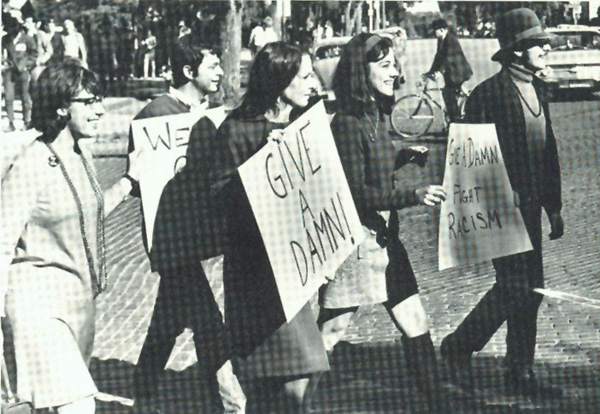
From September of 1968 to May of 1969, student activism burst forth from universities all over the world. Ideas of "change" filled the air like thick black smoke, but did the fires of student power ignite at the University of Nebraska? (Note: during the 1968-1969 school year, the University of Nebraska solely meant Lincoln; Omaha was still Omaha University). The University's activism may have seemed "watered down" in comparison to Columbia, Berkeley, or Mexico's National University, but why should Lincoln be compared? Although a large number of students on campus were not active, for the size of Lincoln, its location, environment, and the campus' lack of diversity, the students who were active did what they could with what they had. Yes, apathy was prevalent, but no, it was not all consuming. The Daily Nebraskan, Buffalo Chip, and 1969 Cornhusker yearbook were made and largely read by University students and what better way to look at students' actions than through the eyes of other students? Student editor of the Daily Nebraskan, Jack Todd, often wrote of student apathy while featuring "controversial" topics. The Daily Nebraskan also featured political cartoons centered on local, national, and international issues. The 1969 Cornhusker's editor Rodney Powell described his opinion on student attitudes on the last pages of the yearbook. The Buffalo Chip, though based in Omaha, had several student contributors from Lincoln who also reported on student apathy as well as the formation of new groups (like the NDRU). After examining these artifacts, is apathetic really the first word that comes to mind? If so, how "active" is active enough to be considered an activist? Looking at Nebraska in a national and international context, it's clear that the level of activism on other campuses was often at a higher level, but by comparing the University of Nebraska to such institutions not only belittles what did take place on the campus, but de-emphasizes the ways in which NU's small movement reflected the larger one. The University of Nebraska was not the "citadel of apathy" as stated by the 1969 Cornhusker and while the movements for student power may have been subtle, may have been smaller than Berkeley or Columbia, at least there was action, at least something was happening. To call the University's activism a "watered-down innocuous version of everywhere else" is both fitting and unfair; it is true that the campus activists took note of big brothers Columbia and Berkeley, but what campus didn't? It is also safe to say that action in Lincoln was on a much smaller scale, but Lincoln was a small city in a conservative climate. It is unfair, however, to conclude from these facts that all of the University was indifferent, nay blind, to important local, national, and international issues. To call the University the "citadel of apathy" is slap in the face to those students who worked to awake student action, to those students who did take action, and to the very Movement itself. The point of student power was not "who can do it bigger" or a contest of which campus is the most active and therefore cares the most, the point of the Movement and of student power was to change something and by looking at the 1968-1969 artifacts and the University today, it is apparent that things did change. | |||||
| |||||
